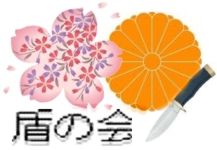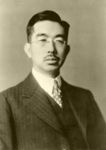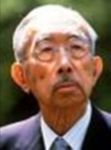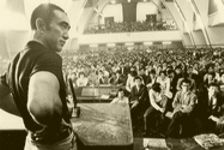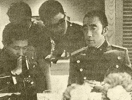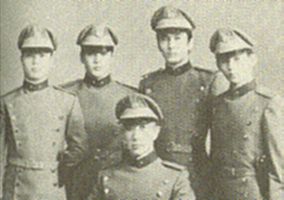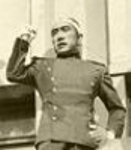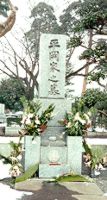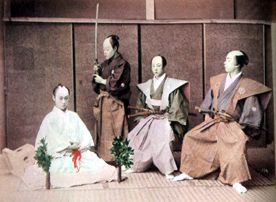| Makoto | Hagakure | Ukiyo | Seppuku | Zen | Kamikaze | Yakuza |
| Shinto | Tatenokai | Tanaka | Jibakutai | Jieitai | Mishima | Chu Hsi |
![]()
THE SHIELD SOCIETY
This is where Mishima Yukio has been put. His seemingly unrelated activities were, in this context, absolutely normal, common, unexceptional, ordinary, coherent and cohesive -- within the warrior class. The problem was, Japan wasn't ruled by this class in 1968. It was in fact the year the 'economic mammals' were about to get launched into the world.
But there surely were some people who still venerated samuraihood. Mishima didn't want any nostalgist around him except himself; besides, he naturally disliked the thought of getting followed by non-beautiful people, while everybody after 40, except himself, was physically and mentally repulsive to him; "At 40, no one can even die beautifully," he wrote. "No matter how hard one tries, the death would still be too ugly. After 40, a man has no choice but to force himself to keep on living." (in an essay, Fukei, 1962). So he did some scouting in universities, and ended up with around 50 students, all in late teens or early twenties, to be members of his 'Shield Society', or 'Tatenokai' in Japanese, which has been rarely abbreviated (into 'SS') because of the repulsive connotation necessitated by the history of 'Mishima's friend' Hitler (he published a book titled My Friend Hitler -- Wagamoto Hittora, in Japanese -- in 1968; but the content had nothing to do with that Hitler). In 1853, one of Mishima's ancestors, Matsudaira Katamori, built the most famous militia in the history of Japan -- the Shinsengumi (click here for story and pictures). This band cut people's heads off as a living, and in its heyday the heads didn't only belong to Emperor Meiji's supporters or rival assassins from the Pro-Meiji compounds, but practically anyone in its way. This militia, though of course had no place in the lawful sphere of Japan, was semi-official when born and fully official when dying; as Shogun Tokugawa's own bodyguards. So, though the Shinsengumi itself can't be said of as political, the reason for their existence was. As about its legitimacy, it had none; about its necessity, there was no such a thing. Mishima Yukio's Shield Society had no legitimacy or necessity to exist at all, and there was similarly no reason whatsoever for its being in this world, as far as people other than Mishima was concerned. But he proceeded anyway because there was no cop banging at his door demanding such reasons. He financed this private militia, and gave them some military-like uniform, complete with something like a Hitlerian cap for each, with a logo of the Minamoto-like war helmet ('kabuto'). The uniform is actually like the Japanese High School's today, only differing in the buttons and the color (Mishima's SS uniform was dull brown). The Shield Society was Mishima's squad of his very own toy soldiers, with which he could have done anything; yet he was never really autocratic there. Nonetheless, because of the military training they had to endure (under real drill-sergeants of the Japanese 'Self Defense Force'), most of the recruits dropped out. The link Mishima's Shield Society had with the Japanese military, which was never called such just to fulfill what the Constitution said (it said "No Armed Forces") was established in 1969 when Mishima applied and received permission to train his militia at the Japanese Army ground, i.e. the HQ of the Jieitai. Such things were a piece of cake to a man who had been a living national treasure as Mishima was; his old school mates were in the high echelons of the bureaucracy, he was 'a friend' to Ministers and the PM, and he even had met the Emperor himself.
The Japanese military has always been noncommittal about this episode, which is something very natural; besides, not much talk has ever been coming from that direction since Japan was born anyway. As a result, we know practically nothing about what the people at the Army -- oops, 'Self Defense Forces' -- thought and felt about having Mishima's boys around their vicinity, except what's in the most official press-releases. Yet the military people's opinion might have been no different from the rest of the world's. This Shield Society was seen as "Mishima's latest prank" by most people of the time. It wasn't even an elegant or 'civilized' way to waste money, and no ideology was professed there either, while Mishima, in every occasion of his 'advertising' the Society, couldn't (I think he just wouldn't) nail any definite purpose for the Shield Society. All members of the Society gathered from time to time to have some 'discussions' -- i.e. where Mishima Yukio spoke and they listened. They also went to military training with real guns on Mount Fuji (why this choice of location is significant, see the page about Shintoism). The training consisted of walking in the snow for hours and nothing whatsoever else, according to Henry Stokes and other newsmongers and testimonies of ex-members of the Society. And they held routine formal ceremonies in full uniform like all militias on this rickety ol' planet always do (the Indonesian penchant for such a thing, that has been not just the military but also all civilians' habit, is the legacy of the Japanese occupation between 1942 and 1945). As of course you have guessed, the Shield Society consisted of some minds that, if combined, wouldn't have been equal to half of Mishima's intellectual capacity. Unfortunately the usual formula of 'brainless but sturdy' creations didn't work there, either; at least according to some observers a number of VIP's within Mishima's Society were not even routinely healthy. But Mishima only laughed whenever confronted with such observable facts. He wasn't perturbed either that no tentacle of the world's mass media got interested in the Society. It's a bit far-fetched if we think that he had decided to launch a campaign that would snatch all media's attention, but this was possible, though the idea must have just shot itself across Mishima's mind and then kept in an unused folder at the back of his head.
In 1966, Mishima Yukio wrote that the aim of his entire life and every activity he's been doing was "to acquire all the various attributes of the samurai." This he saw as something 'beautiful'; it was the 'beauty' of samuraihood that he craved. To be exact, the beauty of the samurai's death (Mishima would have loved Tom Cruise's movie The Last Samurai). To most of us, certainly Mishima's glorifying of death sounded not just strange but downright psychopathological. The samurai of the history of Japan did not, as a matter of fact, glorify death. What they did was just accepting death as a consequence of life, so that their craving was 'the correct kind of death' -- for their Lord, for their homeland, for their clan. What they saw as glowious was not death, an sich, but what it was for, including how it was attained. Mishima Yukio had nothing to die for; that far every superficial observation was correct. But did he really have nothing to die for? He did; the Emperor. As long as Japan is still standing, so the romantic Bushidoist in Mishima's head said, everyone born as a Japanese could die as a Japanese in the most Japanese way -- for the Emperor, since His Majesty is the one and only tie that holds the entire nation together (the Japanese of old is supposed to have come from a single source, remember?), not by democratic 'social contract', not by authoritarian force, but by 'natural' (i.e. 'divine') inevitability. (See another case involving Emperor Hirohito at another page; click here). To the Emperor, Japan -- the nation and the state -- owes its very existence. So all Japanese of all times have their duty to show their gratefulness for this, to uphold loyalty, to the Emperor. Being against the Emperor, disloyal to him, or neglecting the duty to him, is horrific not only because it means you are against your god, but more than that it means you are against yourself. That's why all rebels and people who coveted the Throne in the past never succeeded; not even once (see the History of Japan). The so-called 'way of the warriors' of the Japanese stressed duties, self-negation, and self-sacrifice, which are all fine verbs, only they simply must be followed by nouns. In a glance you would, as everyone did, find no such nouns at the tail of Mishima's verbs to this direction, except -- of course -- himself. But death for oneself is certainly not samurai-like. Hence, Emperor Hirohito must accept this unsolicited and un-needed sacrifice. Let me remind you again of what was written by one of the greatest 'nationalist writers' of Japan -- some even say he was the first of this genre --Yoshida Shoin (1830-1859) -- the philosophical backbone of the Meiji Restoration of 1868 even as it happened when he was no more:
About how Japan is to be called, see History of Japan at another page. Meanwhile, 'the way of the warriors' had experienced a massive overhaul under the reign of the Tokugawa shogunate, between 1603 and 1868. The Tokugawas launched the thing named 'Bushido' in 1717 (see history of the Bushido at the previous page). It put in writing what had been adhered to namelessly by millions of samurai until that year; but the highlighted parts, which the shogunate put all their propaganda into, were only the parts that secured the clan's grip upon Japan. The Emperor wasn't mentioned even once in this string of Tokugawa's self-preservation propaganda. The shogunate of course said it assumed everyone already knew that the ultimate loyalty of every Japanese was to the Emperor, so it didn't need to get written. In practice, the clan ruled like no other clan ever did; and that's a great chunk of the cause of the Meiji-Tokugawa war of 1853-1890 (see another page for a full account). Mishima Yukio's ancestry, though just a faint whiff of it was of a warrior clan's, was of a clan who ruled -- the Matsudairas, just in case you forgot, were the Tokugawas; 'Tokugawa' was a name invented by Ieyasu when he was 24 (see history of the Tokugawa clan again). Yet, the stance that he claimed to have taken was not the same as his grandma's predecessors. About the famous Mishima's Meijian Shintoism, it's been annoying me to browse so many works that clearly show how the Japanese since 1945 submit to the pressure of the 'West' even in this matter, in the name of the alien 'democracy'. With all due respect, wherever pluralism isn't upheld and advocated, there can be no such a thing as 'democracy'. And this happened in the aftermath of WW II when Emperor Hirohito was forced to add, to his announcement of defeat, an acceptance of the non-Japanese state of mind that the Imperial DNA never trickles down from the gods'. If Japan really truly honestly thinks this is best for them, no problem. But if they do it just to appear okay to hang out with in the eyes of the NATO or so, well -- that's most meaningless and untrue. There is nothing more despicable than lying to yourself. Mishima was disturbed by it, too: "Why should the Emperor be a human being? Why can't he be a god, at least to us the Japanese?" (1966). It doesn't need any Nobel Prize candidate to see how disturbing the 'way of the samurai' was to caucasians, because the European counterpart of the samurai, the knights of medieval ages, derived their codes from the Church. Their propellant was religion. The Japanese samurai never dug religions for this purpose; their codes were developed from philosophies (for Shinto actually is, so is Zen). In place of Abraham's God, there was the Japanese Emperor. This was unacceptable to the caucasian minds. Thus Mishima's choice of this subject of devotion was never understood. Even worse than that, Mishima had been seen as one 'most Western Japanese' by them; when he turned out to be not such a creature, the readiest comfort was the thought that Mishima must have gone insane. You can already find such records of typically caucasian bewilderment inside the newspieces and essays and later also biographies of Mishima Yukio, concerning his marriage thru a matchmaker (see previous page). No caucasian could cope with this fact of Japaneseness. They all thought Mishima was 'eccentric' for doing it, or 'proven to be a weak man with no independent mind', or he was simply 'has no interest in women because he was gay'. Just because you happen to live with a Japanese girlfriend, doesn't mean that you know the Japanese. Too many smart people have been so airheaded about it that they never even knew Japaneseness when it passed right under their noses.
People said that Mishima Yukio never gave any warning of what he had set his mind to do on November 25, 1970. A few others, like, once again, Henry Stokes, claimed to have been sensing symptoms of 'unusual behavior' such as that Mishima got easily excited and unusually aggressive those days, and that "He implied that I might as well pack my bags and leave Japan as 'no foreigner could ever understand Japan'" (Stokes, 1971:24). This was a Tokugawaist trait (remember the 'Expel the Hairy Barbarians!' heard daily in Kyoto in 1868?). Mishima would have found the caucasian's patronizing attitude getting on his nerves when Stokes looked as if he was about to take him to a shrink. The photographer who took the one and only picture of Mishima Yukio's 'special squad' in the drama, consisted of Morita Masakatsu, Koga Hiroyasu ('Furu Koga'), Koga Masayoshi ('Chibi Koga'), and Ogawa Masahiro (see the pic below; if you wonder why there were two Kogas with nothing like the same DNA shared, see the history & meanings of Japanese names at another page of this site), couldn't have guessed why Mishima wanted this pic taken, either.
'Masakatsu' means 'victory of truth', 'Hiroyasu' means 'immensely calm' or 'very peaceful', 'Masayoshi' means 'good & true', 'Masahiro' means 'the truest'. Good names, those boys' were. But that morning they were about to do something people took as un-good, even as it fits into the meanings of their names, as they rode with Mishima to the nondescript building called the 'Eastern HQ' of the Japanese 'Self Defense Forces', with which they all had been familiar faces, and went straight into the office of the commander, General Mashita Kanetoshi. In a few minutes, the guests had the General tied-up in his chair, and all entries were barred with furniture, while people who tried to interfere were cut by Mishima Yukio himself as he was the only one among them with a lethal weapon (his warlord sword -- while one of the boys got a short blade). I have to say first that no one was killed, although some officers were probably fainted not because of the loss of blood alone but more because of the shock and an unspoken other thing that resembled understanding though would never be admitted as such. Then Mishima forced the soldiers -- or whatever was their official title, members of the 'Self Defense Forces' -- to assemble under the balcony, where he appeared like in the pic above, wearing the 'Karate Kid bandanna' (remember the old summer flick of Ralph Macchio's?), and delivered a speech asking the men to rise and commit a coup to replace the un-patriotic government, re-arm Japan openly, etc. Predictably, what he got was some 'booo!' and not much else. He calmly ended the speech amidst the brouhaha, and walked back into Mashita's office. There, he committed seppuku, followed by Morita Masakatsu. Mishima's seppuku was perfect. He had 'rehearsed' it for years since the making of his movie 'Patriotism'. Morita's seppuku was casual; he had no strength to inflict anything better than a scratch on himself. Only it didn't matter, because the only swordsman among them besides Mishima, Koga Hiroyasu, did his job (slashing the seppukuist's neck) as the assistant perfectly. It was Koga, too, who snatched the sword from Morita earlier when Morita, his true self emerged exactly when it was supposed to get suppressed, wounded Mishima badly on the back and shoulder instead of his neck, because of his clumsy way with swords. Stokes told about the event the same way many others did; he said Mishima wanted to be watched when committing seppuku, and that it was why he did it first, and not let Morita to do it before him. For God's sake, what a ridiculous statement! If you know just a dash of the way it went in the history of Japan, you would find that every Lord did it before everybody else; and his assistant then did the same after he had died. So, even though Mishima was of course craving an audience for this last act in his drama, this had nothing to do with the procedure, since it was flawlessly adhering to the rule. His fault was that he took Morita to be a much better samurai than the boy actually was. Morita was completely incompetent with swords, and he lost his nerves the sec Mishima started the seppuku. Anyway, all newsmongers were waiting outside, and after the remaining three of the Society members handed General Mashita back to his deputies, and surrendered to the cops, and tried (Mishima had paid for the lawyers for the boys' defense in court), Bushido regained its currency like in the World War. In the name of 'humanism' -- something caucasian, that has been campaigned for as 'universal' -- the Japanese high-brows and politicians said bad things in turns about Mishima Yukio's 'Black November'. But no matter what, actually they all knew it took no mere guts to do what Mishima did, but also some larger-than-life stuff that might have been entirely private in Mishima yet Shintoist and Zennist in most Japanese of all times. Japan said it was shocked like Americans and Europeans were; but they couldn't have been, in truth. What was unexplainable and scary to others, the Japanese themselves should have understood, unless the nation had all been contracting historical amnesia. Just a few headaches before the Mishima event, they had seen Lieutenant-Colonel Aizawa Saburo storming into the office of General Nagata, the way Mishima did, though the aim of Aizawa's was to kill the boss -- which he did, after which he was to get so great a fandom when tried before executed, because of his loud defense that he did it in the name of, and in the interest of, the Emperor. This happened on August 11, 1935. (Click here for another similar case).
So 1970 was the year of the revival of Bushido, in what it is today around you: a vast array of different attitudes and often conflicting interests. In the Northern hemisphere, after this Mishima Drama, people made cults of the samurai -- though their definition of samuraihood varied in accordance with their knowledge about it, which was, as a universal rule, rather patchy and sketchy and even funny. So, what does Mishima matter to Bushido? His death, and his uniformed boys of the Shield Society. Click into any J-Pop and anime site now and you'd find zillions of movies with exactly the same structure as Mishima and the Society (minus seppuku). It was Mishima Yukio who, in a sense, brought Bushido and samuraism back to the world. His death lifted up the flimsy cloak of anti-violence, not just in Japan but anywhere else, so that the issue could be dealt with healthily as a civilian's urban problem, and not as an unspeakable phantom of military wars that you can do nothing about. The trauma of WW II wore off as the Bushido was depicted in whichever way people liked thru the popular media. And Japan came to be no longer ashamed of their history of samuraihood afterwards; unconsciously Mishima's aesthetic view of it has been taken as the average Japanese frame of mind about the subject since 1970, leaving out, as a matter of natural abhorrence of the distasteful, Mishima's sado-masochist streak that was originally interwoven there.
The usual approach his caucasian biographers have taken has been consisting of the semi-unconscious patronist look at him as you might have when talking about the mentally-challenged, plus an utter incomprehension of the 'way of the warrior' no matter how 'familiar with Japan' they claimed themselves to be (see again Henry Scott Stokes' The Life and Death of Yukio Mishima, 1971; Stokes was the first man converting Mishima's death into hard cash thru a book). Hence statements which underlying thought was "But the samurai is no longer Japan now!". When Mishima did what he did, it was 25 years after the World War II. Japan was to have no armed forces anymore after August 1945; what it has until today is the euphemistically-dubbed 'Self-Defense Forces'. But the trauma of Japanese imperialism was still gnawing other peoples on this planet in 1970's -- Indonesians might have been the first to stash away the inhumane invasion of the Japanese soldiers as soon as the country stood up on its own feet (we only cared about making the Japanese, out of guilt, to finance the Indonesian infrastructure-building, or so it seems). But the Koreans and citizens of Myanmar, for example, couldn't get so easily extricated from the haunting devastation caused by Emperor Hirohito's 'Great East Asia' program of 1942-1945. The Japanese's former enemies in the Northern Hemisphere also wouldn't forget it too soon. And the lingering aftertaste that was so hard to spit out was around the samurai. Even in 1890's no Japanese was allowed to jump off their ships with anything that might be used as a weapon, in all British colonies -- officers said everybody was terrified already whenever a Japanese started to look rather unfriendly. The same fear persisted after WW II. As I have said, by 1970 Indonesians already forgot about the Japanese invasion; but at the mention of the word 'samurai' people of my grandma's generation still shudder. Really. And why so? Because of the 'Bushido' that the Japanese had been so overzealously digging in order to explain themselves to caucasian nations, and to justify all its imperialism since the Meiji times at the turn of the century. Hence the mass executions of natives, torture-sessions of caucasians, incessant forced-labor, organized rapes, reduction to subservience and absolute poverty, that happened to the population of Southeast Asian countries between 1942 and 1945, were all seen as the samurai's doing, and as the application of 'Bushido'. And many Japanese soldiers in the WW II openly fluttered their samurai war banners, so to speak, for all to see (click here for samurai clans' crests and battle-banners). In Indonesia, for instance, the highest level of the Japanese military pyramid was occupied by Admiral Maeda; while the plaza in Jakarta at the time was named 'the Ikeda Plaza'. Ancestors of both modern Japanese soldiers were warlords under Oda Nobunaga's command (click here for pictures and profiles of Oda Nobunaga's Army & Navy personnels). Admiral Maeda has been remembered kind of fondly by the people his empire had invaded -- according to Indonesian historians, he was as good as Lord Maeda Toshiie always had been, although virtually no Indonesian knows who Toshiie was (I only concluded this from the descriptions about Admiral Maeda's personality and style of governance). Anyway, to the rest of Asia, it didn't matter if the true Bushido forbade all the atrocities the Japanese invasion caused. What they saw was just that Bushido was the spirit behind the Japanese imperialism, because the Japanese themselves kept saying so. Besides, the Bushido, in the rhetorics of 1930's, came out as a truly fascist and xenophobic and racist creed that put Japan into unshaken unity and put the rest of Asia into smithereens. So, whenever Mishima Yukio wrote and talked of the divinity of the Emperor, nationalism, patriotism, sacrifices for the country's sake, national honor, and such dangerous topics in the unsuitable climate of the snaily healing-process after the WW II, people put him off, saying that he's raving, out of date, the writing sucked, and so on, while underneath the jeers a collective fear was recoiling, both among foreigners and among the Japanese themselves. Of that Mishima said that the Japanese had to start to recognize and accept 'the dark side' of the national temperament.
One more thing that characterizes the caucasian thoughts and feelings about Mishima's death (and thru it, the Bushido and the samuraihood in general) is that it was a suicide. All Semitic religions -- Christianity and Islam particularly -- condemn suicide. They book the hottest part of hell to be reserved for such sinners. Say whatever you may about 'modern Europeans/Americans' who have been mostly either agnostic or atheist, the horror of death and suicide can't get erased from the mental environment they all have grown up in. That makes Mishima's Black November a double dose of sins. More than that, he could have been nailed as the one inducing Morita to copy his suicide, and such a role is punishable in virtually all laws. The Kogas and Ogawa were tried and sentenced, but the 'Western' observers still couldn't see anything familiar -- some of them have wasted time to write of the 'horrible law of Japan' that didn't accuse Koga of murder (i.e. for being the assistant of both Mishima's and Morita's seppuku). But what can the law, much of which was imported from the US of A in 20th century, do, facing a totally lawful action practiced in Japan since the year 1100? As a tradition, seppuku was established by the suicide of Minamoto Yorimasa (click here for story and pictures). Before that, it was already done, but not fixed yet as a part of the samurai's way.
Seppuku of that category is inseparable from wars. The samurai did it when defeated, since being killed by the enemy was shameful and being a prisoner was the ultimate dishonor. Among the historical samurai who committed it were the most famous role model of all times, Minamoto Yoshitsune, and the overlord of overlords Oda Nobunaga. In 1945, thousands of Japanese officers all over Asia did it, too. This is an application of Bushido; you have to keep your integrity (Minamoto's and Oda's), and/or you have to 'apologize to your boss' for the defeat (the World War II officers'). Seppuku was also a way to express sincerity and to prove loyalty (which are parts of Bushido's 7 virtues) whenever a samurai did something that displeased their boss or beyond their jurisdiction. A well-known example for this is the suicide of Hirate Masahide, the advisor of Oda Nobunaga's father (click here for story and pictures). A 20th century specimen of the same kind is the Minister of War Anami Korechika's in 1945 -- in his case it was also a suicide upon a defeat at war. Another type of seppuku is the one forced on you when you lose and surrender, as what happened to the Bushido hero Bessho Nagaharu in 1582 (the winner was Toyotomi Hideyoshi), the Christian warlord Konishi Yukinaga in 1600 (at the battle of Sekigahara won by Tokugawa Ieyasu), and the famous 47 masterless samurai. This was the most honorable punishment to members of the Japanese warrior class. If they wanted to do it but the enemy refused to grant the right to, it means they were not seen as worth respecting as fellow-samurai. The crybaby Shogun, Ashikaga Yoshiaki, asked to be let to commit seppuku after his conspiracy to assassinate Oda Nobunaga failed to execute the deed; Oda Nobunaga's reply to the plea was "Don't make me laugh!" and Ashikaga was driven out of Kyoto without being harmed, as well as without any shred of honor. Ishida Mitsunari suffered the dishonor in 1600 when he was held prisoner by Tokugawa and wasn't offered to commit seppuku. But Konishi Yukinaga refused the honor; "Thank you," he said to Tokugawa Ieyasu, "but my religion forbids suicide." And there is also seppuku that serves to show loyalty, love, devotion, etcetera, like all the suicides of samurai boys simultaneously with their geisha lovers or townsgirls, which always happened under the Tokugawa shogunate's rule, especially since 1700. No matter how sordidly sentimental this looks to you, it is as honorable as other seppuku by one's own will -- seppuku, in such cases, was the only way to show that the doer wasn't about to compromise his class' rules by following his 'selfish' need of romantic love that he wasn't allowed to nurture to begin with. This category also comprises of the abstract suicide like the one done by the hero of the Japan versus Russia war, General Nogi Maresuke (b. 1849), with his wife, who committed seppuku when Emperor Meiji died in 1912, with the purpose to accompany His Majesty thither. Then there is death whose value equals seppuku, since it is done to fulfill what the 'way of the warriors' demand of the samurai. It's the jibakutai, i.e. the 'great death for the lord's sake'. The most famous warrior-monk, Benkei, did it for Minamoto Yoshitsune in 1189. A Tokugawa soldier did it when Ieyasu's life was threatened at the absolute defeat in the battle of Mikata plains, 1572, which was won by Takeda Shingen. The soldier died pretending to be Tokugawa Ieyasu, something he did to give his boss time to flee. The famous Generals Baba Nobufusa and Yamagata Masakage did the same for the memory of Takeda Shingen in the battle of Nagashino (1575), which they knew would only lead to death, yet they rushed into it just the same, following what Kusunoki Masashige and Nitta Yoshisada had done for Emperor Daigo II in 1336. And if the 47 ronins didn't survive and then did seppuku, all of them would have done a jibaku for Asano Naganori in 1702. In 20th century, you got the hundreds of kamikaze pilots (click here for story and pictures). Which seppuku was it, Mishima's? Although his last words were "Long Live the Emperor!" and all his statements before the day put Emperor Hirohito as the one he would die for, the Emperor clearly was in no need of Mishima's soul. Failing to see death as an aesthetic feat as Mishima saw it, while notions of his death as a way to express a protest (hence something Bushidoist) was not accepted either, the rest of the world just couldn't see any justification for his seppuku other than seeing it as being based on purely romantic reasons or alternately as a proof of mental illness. But Mishima's famous statement about the ugliness of living beings after the age of 40 -- which has been pointed at as evidence that he was being excessively romantic and/or completely out of his mind -- was not even original; his writings about 'beautiful death' and the opposite were nothing new. So Mishima's thought here isn't weird and isn't abnormal. On the contrary, it is commonplace in the context of samuraihood. Dying young has always been a samurai thought since Year 1 of the Japanese calendar, and this is not just because of the actual short span the samurai in the constantly-warring country could expect. It is the samurai's view of death, the Buddhist 'ukiyo'. You can see the bold expression of the same thing in all Japanese poems that always take 'morning dew' and 'sakura' as symbols of the fleeting short life; dew evaporates quickly and cherry-blossoms die right after blooming. The birth of the kamikaze squad in World War II was even directly founded on this same notion (click here). 640 years before Mishima wrote such things down, Yoshida Kenko has written it in his timeless Essays in Idleness (Tsurezuregusa -- see another page). Here is a direct quote:
Yoshida Kenko, for writing such stuff, has been immortalized in the classical literature of Japan. But some people take Mishima, because of his writing of such stuff, to be 'in deep emotional trouble', or 'having a sexual crisis', or other such typical comments after Freud, to explain the 'why' of the suicide to themselves. Some others believe that Mishima was genuinely patriotic and heroic, or similar reactions to that direction. The first group maintain that Mishima committed the 'double-suicide' commonly told of in classic Japanese literature, with his 'lover' Morita Masakatsu, to avoid public disgrace, since people were still very openly homophobic those days. The second 'club' say that Mishima died for his belief in Bushido, even for the greatness of Japan, even though among the 'members' there are those who think of Mishima's issue (re-armament of Japan) as 'immoral'. The divisive line in Mishima Yukio's fandom still exists until this minute. The Mishima Museum (opened in 1999) has been clogged by both sides in heated debates that have been characteristic of the fandom since November 25, 1970. |
|
Previous
Page: |
NEW Black Dragon Society |
Next
Page: |
|
Site & Rap © 1996, 1997, 1998, 1999, 2000, 2001, 2002, 2003, 2004, 2005, 2006 Nina Wilhemina
All rights reserved. Every borrowed image at this site is put for non-profit educational purposes only.
HOME
 LINKS
LINKS
 CONTACT
CONTACT
 CREDITS
CREDITS
 COMMENTS
COMMENTS
Sources tapped for this page: Nihon Shakai no Kazoku teki Kosei (Tokyo: 1948); Kono Shozo, Kokumin Dotoku Yoron (Tokyo: 1935); Anesaki Masaharu, Nichiren, the Buddhist Prophet (Cambridge, Mass.: Harvard University Press, 1916); Robert Cornell Armstrong, Light from the East, Studies of Japanese Confucianism (University of Toronto, Canada, 1914); Sasama Yoshihiko, Nihon kassen zuten (Yuzankaku, 1997); William Aston, Shinto: The Way of the Gods (London: Longmans, Green, 1905); Ruth Benedict, The Chrysanthemum and the Sword (Boston: Houghton Mifflin, 1946); Charles Eliot, Japanese Buddhism (London, 1935); Futaki Kenichi, Chuusei buke no saho (Yoshikawa Kobunkan, 1999); Kiyooka Eichii, The Autobiography of Fukuzawa Yukichi (Tokyo, Hokuseido Press, 1934); Konno Nobuo, Kamakura bushi monogatari (Kawade shobo shinsha, 1997); Nukariya Kaiten, The Religion of the Samurai (London: Luzac, 1913); A.L. Sadler, The Beginner's Book of Bushido by Daidoji Yuzan (Tokyo: Kokusai Bunka Shinkokai, 1941); A.L. Sadler, The Makers of Modern Japan (Tokyo: Tuttle, 1978); Satomi Kishio, Nichirenism and the Japanese National Principles (NY: Dutton, 1924); Suzuki D.T., Zen Buddhism and Its Influence on Japanese Culture (Kyoto: The Eastern Buddhist Society, 1938); Henri Van Straelen, Yoshida Shoin (Leiden: Brill, 1952); Robert Bellah, Tokugawa Religion; Sato Hiroaki, Legends of the Samurai (Overlook Press, 1995); Masaaki Takahashi, Bushi no seiritsu: Bushizo no soshutsu (Tokyo: Tokyo daigaku, 1999); Stephen Turnbull, Samurai Warlords (London: Blandford Publishing, 1992); Paul Akamatsu, Meiji 1868, Revolution and Counter-Revolution (Allen & Unwin, 1972); Nitobe Inazo, Bushido, The Soul of Japan (Tokyo: Tuttle, 1970); Paul Varley and Ivan Morris, The Samurai (Weidenfeld, 1970); Inoguchi and Nakajima, The Divine Wind: Japanese Kamikaze Force in World War II (Hutchinson, 1959), Seki Yukihiko, Bushi no tanjo (Tokyo: NHK, 2000); Amino Yoshihiko, ed. Edojidai no mikataga kawaruho (Tokyo: Yosensha, 1998). |
